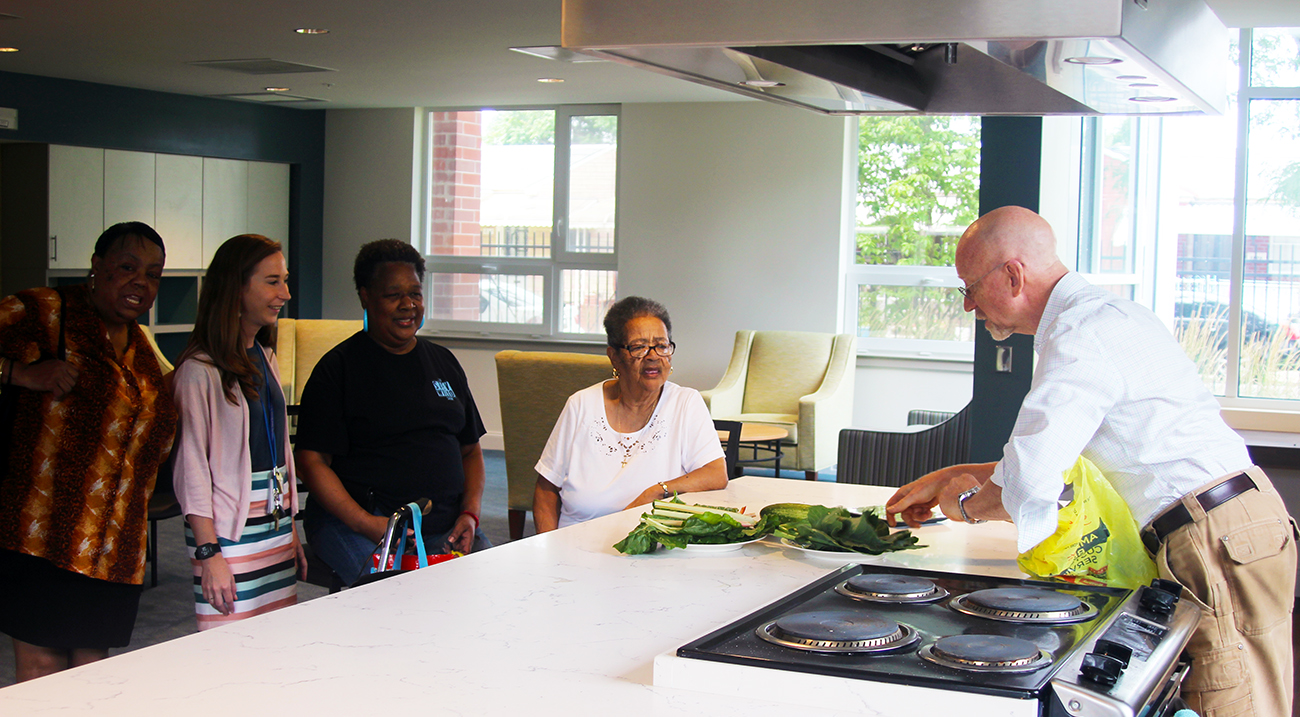
Wellness center director Edwin Rupert (right) of St. John Neumann Place II (SJNPII) inspects vegetables from the senior housing facility’s garden with Ojay Washington, social service coordinator Caroline Morgan, Teresa Thomas and Dale Freeman. One of five senior housing centers, SJNPII recently received the “Innovation in Design” award from the Pennsylvania Housing Finance Agency. (Gina Christian)
An archdiocesan senior housing complex has been designated as a leader in design by the Pennsylvania Housing Finance Agency (PHFA).
St. John Neumann Place II (SJNPII), located in South Philadelphia, received the PHFA’s “Innovation in Design” funding award at the agency’s housing forum earlier this summer.
In particular, the honor highlighted the building’s wellness center, a spacious, multi-room complex that features an upscale kitchen, exercise rooms, common and meeting areas, an art studio and a clinical office for medical examinations.
“It’s a very ‘right now’ kind of design, so people come in here and feel a sense of quality and that they’re being cared for,” said Edwin Rupert, director of the wellness center.
SJNPII is one of five senior housing communities operated by the Archdiocese’s Catholic Housing and Community Services (CHCS) division. The building, which consists of 52 one-bedroom apartment units and a large wellness center, is located adjacent to the 75-unit St. John Neumann Place (SJNP).
[hotblock]
Once a Catholic high school, SJNP was transformed into an affordable senior living community by CHCS in 2008. Due to the demand for such housing, SJNPII was unveiled in 2017.
CHCS provides a full-time, on-site social service coordinator to support the homes’ residents. Presby’s Inspired Life — an independent, faith-based organization that serves seniors — manages the properties, offering 24-hour emergency call services for building issues.
Other CHCS residences include Norris Square Senior Housing (also known as Casa Carmen Aponte) in North Philadelphia, St. Francis Villa in the city’s Kensington section and Nativity B.V.M. Place, the former grade school of Nativity B.V.M. Parish in Port Richmond.
In total, the CHCS facilities house over 260 low-income seniors, with rental fees scaled to accommodate residents’ resources. Major funding for the projects is provided by a blend of tax credits, grants and loans from local, state and federal partners.

St. John Neumann Place II (SJNPII) resident Agnes Muto (center) shows a handmade jewelry project to SJNPII wellness center director Edwin Rupert (left) and social services coordinator Caroline Morgan. Earlier this summer, SJNPII received the “Innovation in Design” award from the Pennsylvania Housing Finance Agency. (Gina Christian)
The PHFA award, determined by a jury of housing professionals, recognized SNJPII’s overall commitment to senior housing and health.
As part of that commitment, SJNPII’s structure intentionally promotes a sense of community while providing independent senior living.
“We had Thanksgiving dinner in the kitchen and common area last year, and some of the residents cooked,” said Caroline Morgan, social services coordinator for both SJNP and SJNPII. “It was actually snowing that day, and the effect was beautiful.”
Stylish colors and solid materials make the space feel like home, said Rupert, adding that even the closets are ample and conveniently placed.
The center’s extensive windows provides plenty of natural light, while enabling residents to enjoy the surrounding lawns and gardens.
The view, along with an array of programs hosted by the center, also keeps seniors connected to the local neighborhood.
Health screenings, exercise and art classes, seminars on Medicaid benefits and wills are among the many activities offered to both residents and older adults from the area.
Starting in September, the wellness center will also offer a series of “retreats to go” facilitated by leaders from Malvern Retreat House.
The overall goal is an architectural and programmatic design that is holistic, meeting an array of individual and community needs, said both Rupert and Morgan.
Rupert added that the design process benefited from a creative, forward-thinking mindset.
“My sense is that the Archdiocese and the funders just said, ‘Go for it. Let’s do something that really works, that’s really good and can be a model for other facilities,’” said Rupert.
PREVIOUS: Ancient chants, Latin texts take on new life at major musical conference
NEXT: Three Catholic churches close in Old City, West and NE Phila.



Share this story